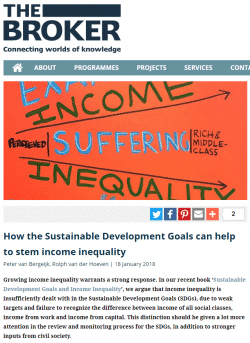
Policy highlights:
- The authors of this blog state that although Goal 10 of the Sustainable Development Goals is to reduce inequality, the targets formulated (including the review and monitoring processes) are insufficient. The development of both the poorest and richest parts of the population are not adequately taken into account, as only the progress of the bottom 40% is reviewed.
- A proper indicator should take into account the income from work, the income from capital, the income of the super-rich (the top 1%), and the average income of the general population. It is of particular importance to pay attention to the behaviour of the rich, as ignoring their domination can influence the social fabric of a country. Also, alternative measures of development should be included, such as the Human Development Index, the Green Economy Progress Index and the Palma Ratio (which measures the income of the bottom 40% of the population in relation to the top 10% of the population and is less sensitive to change in the relatively stable middle 50% of households).
- Stakeholders should: 1) use and develop new and improved measures of inequality, 2) create evidence-based policies, and 3) increase the involvement of civil society (so governments can be called upon to pay more attention to growing inequalities and go beyond vaguely formulated goals and targets) and academics (who can inform such discussions).
- Finally, stakeholders should adopt a rights-based approach to development – e.g. a ‘global social floor’ or ‘social minimum’ – when considering economic, social and cultural rights like non-discrimination, participation and accountability.





